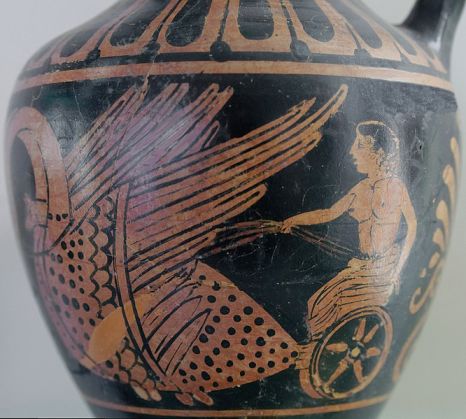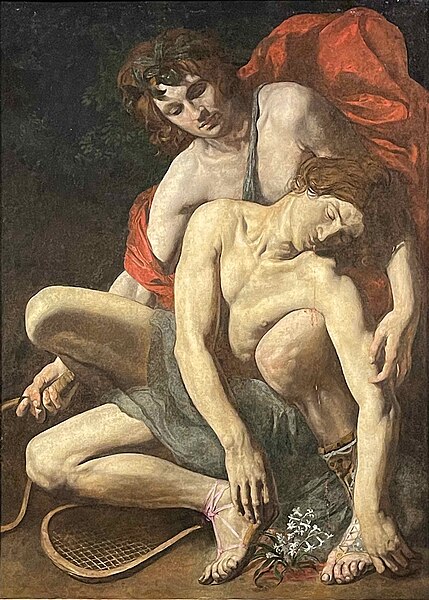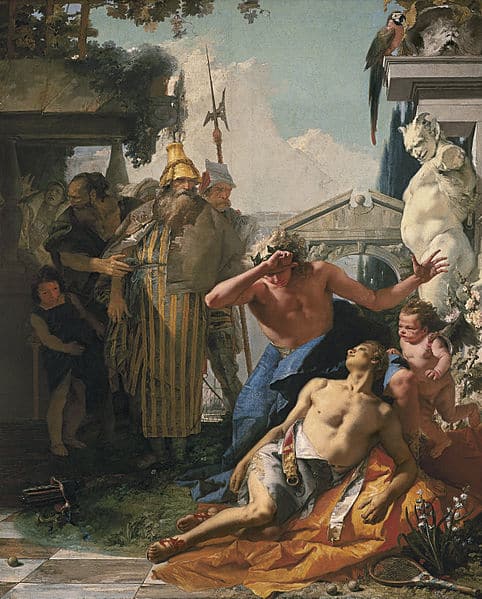In the realm of Greek mythology, the tale of Hyacinth holds a tender yet tragic note. His story unfolds in a time where gods and mortals mingled, loved, and often faced sorrow together, showcasing a delicate blend of divine and human experiences.
Hyacinth’s story is a gentle reminder of the profound relationships between gods and humans, and the enduring legacies such unions could foster. Through the lens of his tale, we delve into a narrative filled with love, competition, and a fateful event that led to the birth of a beautiful flower bearing his name.
Hyacinth Key Facts
| Parents | King Amyclas, Diomede |
| Partners | Apollo |
| Siblings | Polyboea, Cynortes |
| Offspring | None |
| Other names | None |
| Roman name | Hyacinthus |
| Best Known Myth | The tragic love of Apollo |
Name and Etymology
The name Hyacinth traces its roots to the ancient Greek word ‘Hyakinthos’. The etymology is as beautiful as the flower that sprung from the blood of our hero, symbolizing the essence of divine beauty and rebirth. The Roman counterpart of Hyacinth retains the same name, Hyacinthus, a testament to the enduring allure of his narrative that transcends cultural boundaries.
In the annals of mythology, names often carry profound meanings and Hyacinth’s name is no exception. It encapsulates a tale of love, loss, and immortalization, elements that are deeply embedded in the fabric of Greek and Roman mythological narratives. The epithets associated with Hyacinth are scarce, yet the name itself has become synonymous with a tale that resonates with the human experience of love and loss.
The transition of Hyacinth’s tale into Roman lore, with the name remaining unchanged, signifies the universal appeal and the timeless narrative encapsulated in his story. It’s a narrative that transcends the mere mortal realm, venturing into the divine, yet retains a touch of humanity that makes Hyacinth’s tale relatable across cultures and eras.
Hyacinth Family and Relationships
Born to King Amyclas of Sparta and Diomede, Hyacinth was of noble lineage. His birth brought joy to the kingdom, a new bud in the royal lineage, destined to carry forth the legacy of his ancestors. His childhood was as radiant as the sun-kissed lands of Sparta, filled with the promise of a bright future.

The narrative takes a tender turn with the entrance of Apollo, the sun god, into Hyacinth’s life. Their companionship blossomed into a profound love, a divine-human bond that was as beautiful as it was doomed. The love between Apollo and Hyacinth was a testament to the deep connections that could exist between the celestial and the earthly, a theme prevalent in many Greek myths.
Myths about Hyacinth
The central myth surrounding Hyacinth is steeped in love, rivalry, and a tragic end, elements that are quintessentially Greek. The narrative unfolds with Apollo, the sun god, and Zephyrus, the god of the west wind, both falling profoundly in love with the beautiful mortal, Hyacinth. However, it was Apollo who won Hyacinth’s affection, a fact that brewed a storm of jealousy within Zephyrus.
The Tragic Game
The tale reaches its climax on a sunny day when Apollo and Hyacinth decided to enjoy a friendly game of discus. Apollo, showcasing his divine strength, hurled the disc far into the sky. Hyacinth, eager to impress his divine companion, sprinted to catch it. However, Zephyrus, fueled by jealousy and longing, manipulated the path of the disc with a gust of wind, causing it to veer off course and strike Hyacinth, a blow that proved fatal.

As Hyacinth lay dying in Apollo’s arms, the sun god couldn’t bear the thought of the Underworld claiming his beloved. Thus, from Hyacinth’s spilled blood, Apollo created a beautiful flower, ensuring that the memory of his beloved would endure in the form of the Hyacinth flower. This act of love and remembrance encapsulates the essence of Greek mythology, where the divine often intertwine with the mortal, leading to narratives that are both beautiful and tragic.
The Jealous Wind
The undercurrent of jealousy from Zephyrus played a pivotal role in the tragic tale of Hyacinth. His unrequited love for Hyacinth led to a moment that would forever be etched in the annals of Greek mythology. The story revolves around the theme of divine rivalry and jealousy. Eventually showing how the emotions of the gods could have profound and often tragic implications on the mortal realm.
The interplay of love, jealousy, and rivalry in Hyacinth’s tale is a reflection of the complex relationships that often formed the crux of Greek mythological narratives. It’s a tale that, while rooted in the divine, mirrors the human experience, making it a poignant part of the Greek mythological landscape.
Depiction And Characteristics
Hyacinth is often depicted as a youth of extraordinary beauty, a mortal who caught the eye of the divine. His appearance is synonymous with the beauty of the flower that bears his name, a symbol of love, rebirth, and the fleeting nature of life. The Hyacinth flower, with its vibrant colors and delicate form, is a visual representation of Hyacinth’s narrative, embodying the essence of his tale.
The symbol associated with Hyacinth is predominantly the flower. Symbolizing the immortal love between him and Apollo. A beautiful reminder of a tale of love, loss, and immortalization that is at the heart of Hyacinth’s story.
Representations Of Hyacinth In Art
The tale of Hyacinth has inspired many a brush and chisel, leading to numerous representations in the realm of art. His story, laden with emotion and divine intervention, has been a fertile ground for artistic expression. Often capturing the essence of love, loss, and the fleeting nature of beauty.

One notable piece is the sculpture “Apollo and Hyacinth” by the renowned artist Giovanni Battista Bernini. This masterpiece captures the tender moment of Apollo cradling the dying Hyacinth. It is a visual narrative of love, loss, and the inexorable hand of fate. The expression of grief on Apollo’s face and the lifeless form of Hyacinth are poignant representations of the tragic tale.
Moreover, the tale has found its way into the realm of paintings, with numerous artists rendering the tragic game of discus, the tender moments between Apollo and Hyacinth, and the birth of the Hyacinth flower. These visual narratives continue to keep the tale of Hyacinth alive, a testament to the enduring allure of his narrative.
Mentions in Ancient Texts
The tale of Hyacinth has been immortalized in ancient literature, with mentions scattered across various texts focused on Greek mythology.
Ovid’s Metamorphoses
The Roman poet Ovid included the tale of Hyacinth in his magnum opus Metamorphoses, written around 8 CE. In a notable excerpt, Ovid captures the moment of Hyacinth’s demise with a blend of poetic melancholy and divine despair. This helped immortalizing the tale in the tapestry of ancient literature. He writes:
“The blood which had poured forth, and stained the grass was changed into a flower, which bore letters on its petals, expressive of the grief of Apollo. The flower was very like a lily, except that it was purple in color, and the lily is white.”
Pausanias’ Description of Greece
Pausanias, a Greek traveler and geographer of the 2nd century AD, also mentions Hyacinth in his work Description of Greece. Through his detailed geographical narratives, Pausanias provides a glimpse into the ancient Greek world, including the myth of Hyacinth. His work serves as a valuable source of historical and mythological information. Indeed it is offering a window into the cultural landscape of ancient Greece.
Apollodorus’ Bibliotheca
Apollodorus, a scholar whose works are dated around the 1st or 2nd century BCE, mentions Hyacinth in his work Bibliotheca. This work is a comprehensive compilation of Greek myths and heroic legends. Apollodorus provides a succinct narrative of Hyacinth’s tale, offering a glimpse into the tragic love story that defined him. Moreover it has captured the imagination of many over centuries.
Frequently Asked Questions
The Hyacinth flower symbolizes the immortal love between Apollo and Hyacinth, and the rebirth of Hyacinth’s beauty. It’s a visual representation of the tale, embodying the essence of love, loss, and rebirth.
Apollo, the sun god, and Zephyrus, the wind god, were the key figures in Hyacinth’s life. Their love and rivalry for Hyacinth played a significant role in the unfolding of his tale.
Hyacinth met his end during a game of discus, killed by a discus thrown by Apollo.
The core theme of Hyacinth’s tale is the intertwining of love, rivalry, and fate. It showcases the profound yet often tragic relationships between gods and mortals.
Hyacinth’s tale is a reflection of the complex relationships between gods and mortals, a theme prevalent in Greek mythology. It also delves into the theme of immortalization, a key aspect of many Greek myths.
Giovanni Battista Bernini’s sculpture “Apollo and Hyacinth” is an artwork depicting the tender yet tragic bond between Apollo and Hyacinth. Numerous paintings also capture various moments of Hyacinth’s tale, keeping the narrative alive through visual storytelling.
Featured Image Credit: François Joseph Bosio, Public domain, via Wikimedia Commons
